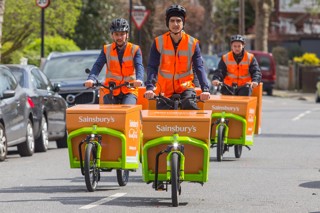
Electric Assisted Vehicles (EAV) has launched the EAVan, a vehicle it claims will solve the issues of urban congestion and pollution.
The EAVan, if you hadn’t guessed from the picture, is offically an eCargo bike and, therefore, operates under the current regulations for eBikes.
EAV, however, says the vehicle has been “engineered down” from a van, rather than up from a bicycle to give it more appeal with fleet users.
“We wanted the EAVan to be as usable as possible by anyone.” said Adam Barmby, technical director and Founder of EAV.
“Getting people out of vans and onto eCargo bikes isn’t easy if they think it’s going to be an awful experience. Being exposed to the elements or being low to traffic isn’t going to appeal to anyone.”
The company started with the idea of the outer body of a light commercial van and added the electric pedal-assist propulsion system.
The EAVan can accelerate up to about 3mph using its electric assistance. After that, simply turning the pedals provides enough power to move up to 120kgs of payload in the cargo area up to a maximum assisted speed of 15mph.
“The amount of assistance can be adjusted, and we have our own gearbox so using the EAVan is very easy indeed, added Barmby.

Power is regenrated into the batteries under braking and free-wheeling to maximise the efficiency of the EAVan, which has a range of up to 60 miles - or further if you piggyback more batteries.
Charging is completed using a normal three-pin household socket and EAV says the batteries are interchangeable to avoid downtime.
The EAVan has been designed to be fully modular and has a wide range of uses from a delivery van or a pick-up - which can be used to clear rubbish or move tools around a site - to a paramedic or security patrol vehicle.
There is also the potential platform for larger vans and Personal Transport Vehicles (PTVs) including taxis, minibuses and even personal vehicles to replace individual cars.
Nigel Gordon- Stewart, chairman and executive director of EAV, said : “If we can reduce the mass of traffic, both in terms of actual weight and sheer volume, as well as remove all toxic emissions using bio-mechanical EAVans and EAVehicles, we’d have a cleaner, safer and much more enjoyable environment in which to live and work. And there’s no impact on business efficiency using EAVans. They’re highly efficient so it’s mainly a culture change that’s needed and EAVans and EAVehicles are really fun to use and a much healthier solution for people as a whole.”
EAV’s next developments include weather- proofing by adding doors, an undertray floor and in-vehicle heating and ventilation system.
The company expects to have vehicles for most uses in towns and cities within the next five years.
Would you consider using the EAVan on your fleet? Let us know in the comments section below.





















Login to comment
Comments
No comments have been made yet.